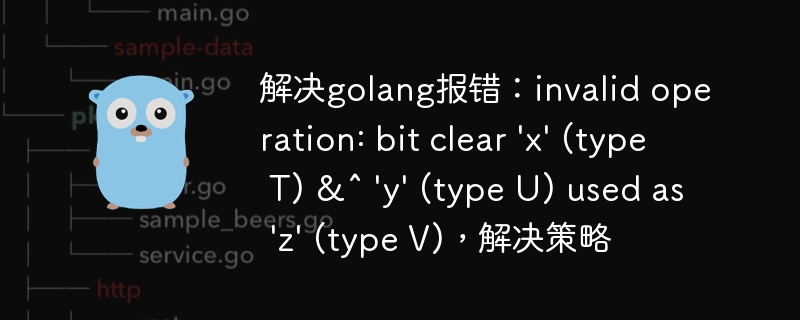Home >Backend Development >Golang >Solve golang error: invalid operation: bit clear 'x' (type T) &^ 'y' (type U) used as 'z' (type V), solution strategy
Solve golang error: invalid operation: bit clear 'x' (type T) &^ 'y' (type U) used as 'z' (type V), solution strategy
- WBOYWBOYWBOYWBOYWBOYWBOYWBOYWBOYWBOYWBOYWBOYWBOYWBOriginal
- 2023-08-19 11:45:24732browse

Solution to golang error: invalid operation: bit clear 'x' (type T) &^ 'y' (type U) used as 'z' (type V), solution strategy
During the development process using Golang, we sometimes encounter some compilation errors. One of the common errors is: invalid operation: bit clear 'x' (type T) &^ 'y' (type U) used as 'z' (type V). This error message means that when we perform a bit clear operation, the type of operation does not match. There are many ways to solve this problem, and I will introduce a few common solutions below.
Before solving this error, let’s first understand the bit clearing operation. The bit clear operation means that the specified bit can be set to 0 by using the bit AND operation and the bit NOT operation. In Golang, bit clearing operations are represented by the ^ symbol. For example, we can use the following code to perform a bit clear operation:
package main
import "fmt"
func main() {
x := 10 // 二进制表示为 1010
y := 3 // 二进制表示为 0011
z := x &^ y // 位清除操作
fmt.Println(z)
}In the above example code, we perform a bit clear operation on the variables x and y and store the result in the variable z. Under normal circumstances, this is indeed a valid operation. However, in some cases, when our operand types do not match, the compiler will give an error message: invalid operation: bit clear 'x' (type T) &^ 'y' (type U) used as ' z' (type V).
To solve this error, we can adopt the following strategies:
- Check the type of the operand
First, we should check the type of the operand Does the type match? When performing a bit clear operation, the operands must be of the same type. If their types don't match, we can do a type conversion before doing the bit clearing operation. For example, we can convert x and y to the same type before performing the bit clearing operation:
package main
import "fmt"
func main() {
x := uint(10) // 转换为uint类型
y := uint(3) // 转换为uint类型
z := x &^ y // 位清除操作
fmt.Println(z)
}Using type conversion, we can resolve the type mismatch and successfully perform the bit clearing operation.
- Check the bit width of the operand
In addition to checking the type of the operand, we should also check whether the bit width of the operand matches. In Golang, different integer types have different bit widths. For example, the bit width of the int type is system architecture dependent, while the bit widths of the int8, int16, int32 and int64 types are 8, 16, 32 and 64 bits respectively.
If our operands have different bit widths, the compiler will give an error message. To solve this problem, we can operate with integer types of the same bit width. For example, if x and y are both of type int8, we should use a variable z of type int8 for bit clearing to ensure that the bit widths match.
package main
import "fmt"
func main() {
x := int8(10) // int8类型
y := int8(3) // int8类型
z := x &^ y // 位清除操作
fmt.Println(z)
}By using integer types with the same bit width, we can solve the bit width mismatch problem and successfully perform the bit clear operation.
- Check the binary representation of the operand
Finally, we should also check whether the binary representation of the operand is correct. When performing bit clear operations, we should ensure that the binary representation of the operand is valid. If the binary representation of the operands is incorrect, the compiler will give an error message.
To solve this problem, we should check that the binary representation of the operands is correct and make sure they are what we expect. If the binary representation of the operands is incorrect, we need to fix them and then redo the bit clearing operation.
To sum up, we can use the above strategies to solve golang error: invalid operation: bit clear 'x' (type T) &^ 'y' (type U) used as 'z' ( type V). By checking the type, bit width, and binary representation of the operands, we can identify and fix the cause of the error and successfully perform the bit clear operation.
To summarize, when encountering golang error: invalid operation: bit clear 'x' (type T) &^ 'y' (type U) used as 'z' (type V), we should pay attention Check the type, bit width, and binary representation of the operands and adopt an appropriate resolution strategy. I hope this article can help you solve this problem and perform the bit clearing operation smoothly.
The above is the detailed content of Solve golang error: invalid operation: bit clear 'x' (type T) &^ 'y' (type U) used as 'z' (type V), solution strategy. For more information, please follow other related articles on the PHP Chinese website!

